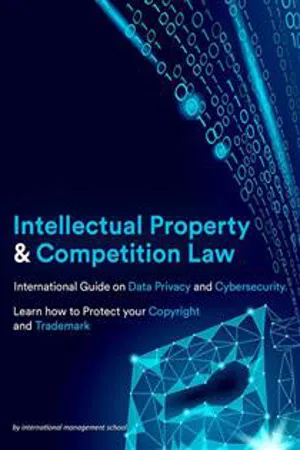
- Italian
- ePUB (disponibile sull'app)
- Disponibile su iOS e Android
Intellectual Property and Competition Law
Informazioni su questo libro
It is important to say that innovation influences the market and its operators, especially about competition conditions. One of the most significant technological advances relates to the possibility of capturing a huge amount of information and the rapid processing thereof (two of the main features that make up the phenomenon known as big data). This not only entails the emergence of specialised operators in these activities, but also makes a "data economy" possible. In this regard, it expands the profitability of business models based on data and gives more strategic value to the collection thereof. The increased possibilities of obtaining revenue from the information lends greater efficiency to the strategy of setting a price of zero in one of the markets on which platform-type (two-sided) business models depend. However, the market in which an operator offers its service at zero cost is not free from possible competition problems in parameters other than price (significantly, quality: whether understood as adequately classified information or the level of privacy offered to users). Therefore, the competition authorities must necessarily abandon a price-centric perspective and enter into an assessment of other parameters already foreseen in the Competition Act. Some of the most recent and significant changes that technology has stimulated in the economy have included the appearance of multiple operators that base their business model on the processing of information and can access it thanks to (i) increased digitisation (conversion of physical assets into information), which has enabled digital interactions (unlike physical interactions, they leave a record – information), and (ii) a large volume of information (Internet and sensors). These changes have not only allowed the proliferation of business models based on information processing but rather, in particular, they can be found in those operators that have achieved the most significant success recently (from Google to Facebook, WhatsApp or LinkedIn, through to Uber and Airbnb). From the industrial revolution and until well into the twentieth century, the most important competitive advantage of economic operators was based on their ability to produce and distribute goods or physical products. However, in recent decades, a particular phenomenon has emerged of the transformation of physical goods (atoms) into information (bits). In other words, the physical format is becoming less relevant while the importance of data continues to grow. A trend which, far from disappearing, it seems will become ever more entrenched, with the eventual widespread use of 3D printers. Thus, the most important competitive advantage appears to have moved from production and distribution to information (data) and its management. Multiple economic operators, aware of the growing importance of data, have invested in aspects related to it, particularly in its collection and processing. This has led to the phenomenon known as big data, characterised by the "4 Vs": volume, variety, velocity (of processing) and veracity. In any case, without addressing at this time privacy considerations, data collection requires an investment meaning that any operator that has such data enjoys a competitive advantage. These large data sets are becoming a core asset in the economy, fostering new industries, processes and products and creating significant competitive advantages.
Domande frequenti
- Base è ideale per studenti e professionisti che amano esplorare un’ampia varietà di argomenti. Accedi alla Biblioteca Base con oltre 800.000 titoli affidabili e best-seller in business, crescita personale e discipline umanistiche. Include tempo di lettura illimitato e voce Read Aloud standard.
- Completo: Perfetto per studenti avanzati e ricercatori che necessitano di accesso completo e senza restrizioni. Sblocca oltre 1,4 milioni di libri in centinaia di argomenti, inclusi titoli accademici e specializzati. Il piano Completo include anche funzionalità avanzate come Premium Read Aloud e Research Assistant.
Nota che non possiamo supportare dispositivi con iOS 13 o Android 7 o versioni precedenti. Scopri di più sull’utilizzo dell’app.
Informazioni
- Competition Policy, Tech, and the Data Economy
1.2 Enter the data economy: European policies for a thriving data ecosystem
Indice dei contenuti
- Cover
- Indice
- Intellectual Property and Competition Law
- Copyright
- 1. Competition Policy, Tech, and the Data Economy
- 1.1 Catalan Competition Authority, THE DATA-DRIVEN ECONOMY. CHALLENGES FOR COMPETITION
- 1.2 Enter the data economy: European policies for a thriving data ecosystem
- 1.3 Big data: bringing competition policy to the digital era
- 1.4 SLIDES - Automotive industry connected car technology and car data
- 2. Big Data and Abuse of Dominance
- 2.1 OECD, BIG DATA: Bringing competition policy to the digital era
- 2.2 OECD - Summary of Discussion of the Hearing on Big Data – what could BD meanfor competition enforcement?
- FOOD FOR THOUGHTS: What are competition authorities talking about when they talk about big data? – linked to OECD hearing above
- 2.3 Unilateral Conduct
- 2.4 Android and Forking Restrictions: On the Hidden-Closeness of “Open”
- 2.5 European commission press release
- 2.6 Podcast - Android – An Open Or Shut Case?
- 2.7 Amazon and the Law of the Jungle
- 3. Algorithms and collusion
- 3.2 CMA, Pricing algorithms - Economic working paper on the use of algorithms to facilitate collusion and personalised pricing
- 4. Intellectual Property Rights: Introduction
- 4.1 WIPO, The role of IPRs in the fashion business: a US perspective
- 4.2 TRADEMARK – from the article ‘Making a mark (WIPO)’
- 4.3 Fashion case: Gucci vs Guess saga: the European episode
- 4.4 3D trademarks in action
- 4.5 COPYRIGHT - WIPO, Creative expression
- 4.6 A focus on copyright and creativity